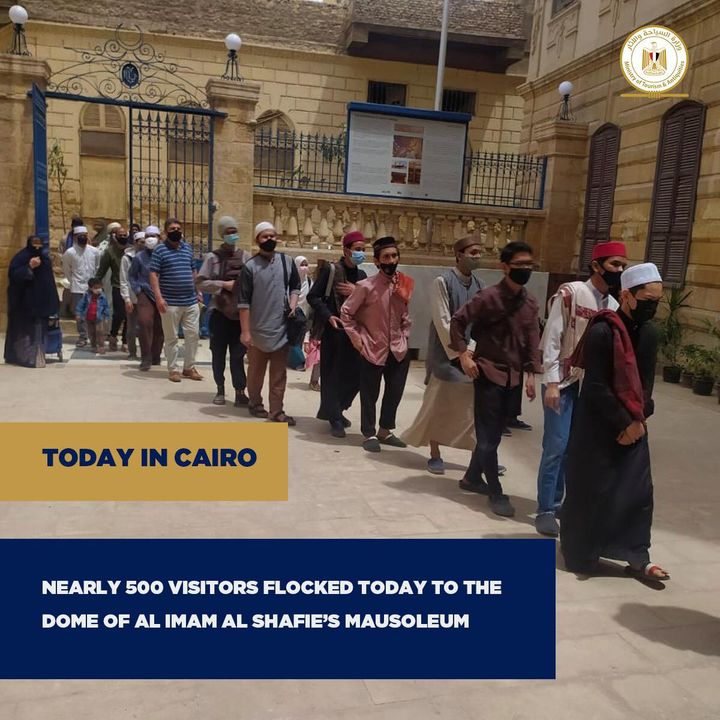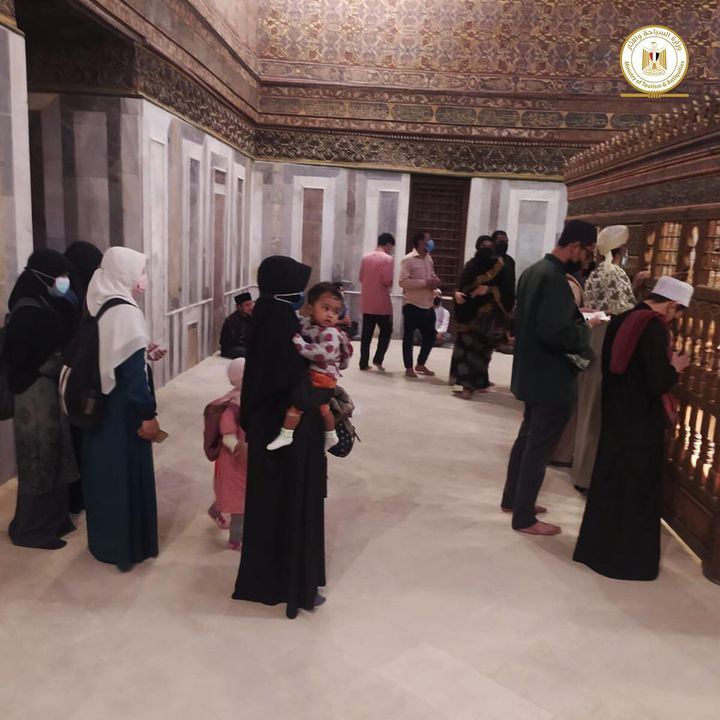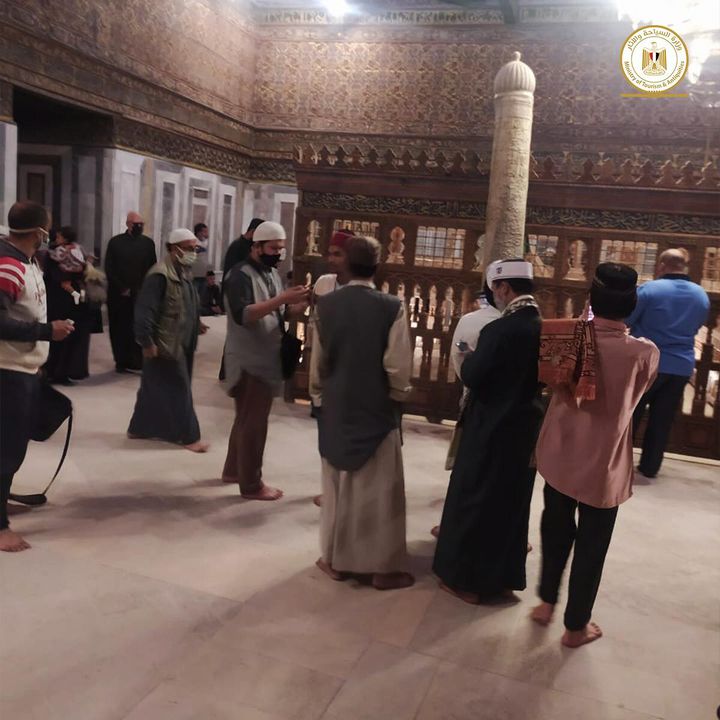وأوضح الدكتور أسامه طلعت رئيس قطاع الآثار الإسلامية والقبطية واليهودية بالمجلس الأعلى للآثار، أن عدد الزائرين اليوم الجمعة وصل إلى قرابة ال ٥٠٠ زائر، مشيرًا إلى أن اليوم جميع الزائرين حرصوا على مشاهدة جميع أجزاء القبة معربين عن إعجابهم الشديد بما آلت إليه أعمال ترميم القبة، واستخدام نظام إضاءة حديث بها لإبراز جمالها الفني والأثري، وجهود وزارة السياحة والآثار للحفاظ على مختلف الآثار المصرية.
جدير بالذكر أن القبة الضريحية للإمام الشافعي خضعت إلى أعمال ترميم استمرت قرابة الخمس سنوات بتكلفة بلغت أكثر من ٢٢ مليون جنيه، ضمن إطار عمل مبادرة الأثر لنا، بدعم من صندوق السفراء الأمريكي للحفاظ على التراث الثقافي وبدعم إضافي من مؤسسة بركات، وصندوق الأمير كلاوس، ومؤسسة ألف.
وقد تضمنت أعمال الترميم الخارجية ترميم الجص المزخرف، أما عن الأعمال الداخلية فتضمنت ترميم الأخشاب الملونة، والتكسيات الرخامية الملونة، بالإضافة إلى الإصلاحات الإنشائية للمباني، وأعمال ترميم الأسقف والتبليط، وكذلك مجموعة من أعمال الترميم الخاصة مثل ترميم التوابيت الخشبية والمقصورات والتكسيات الرصاص، والعشاري وهو المركب الذى يعلو القبة. كما تم تطوير نظام الإضاءة وإضافة لوحات توضيحية تشرح القبة ومكوناتها للزائرين، بالإضافة إلى توثيق مبنى القبة وتفاصيله الزخرفية توثيقًا شاملاً.
وشيد هذه القبة الضريحية السلطان الكامل الأيوبي عام 1211 م/608 هـ أعلى قبر الإمام الشافعي إكراما وتعظيما له، وهو أحد الأئمة الأربعة ومؤسس المذهب الشافعي والقاضي والفقيه والرحالة والشاعر. وفي عهد صلاح الدين الأيوبي قام ببناء تربة الشافعي عام 572 هـ / 1176 م، وهي أول مبنى يقوم على قبر الشافعي. .وينسب الضريح الحالي إلى السلطان الأيوبي الكامل محمد الذي شيده مكان ضريح فاطمي سابق بعد دفن والدته هناك عام 608 هـ | 1211 م.وفي عام 574 هـ / 1178 م، تم الإنتهاء من عمل التابوت الخشبي الذي يعلو التربة. وهو مزخرف بحشوات هندسية منقوشة نقشاً غاية في الإتقان، وكتب عليه آيات قرآنية وترجمة حياة الشافعي واسم صانعه (عبيد النجار) بالخطين الكوفي والنسخ الأيوبي، أما القبة الخشبية الحالية فهي من التجديدات التي قام بها السلطان قايتباي عام 885 هـ / 1480 م ، كما جدد الضريح أيضاً السلطان قانصوه الغوري، وقام والي مصر علي بك الكبير أيضا بتجديده.
Five days after the Inauguration of the Dome of Al Imam Al Shafie’s Mausoleum, hundreds of Egyptian and foreign visitors flocked to the dome with regard to the implementation of all planned precautionary measures.
Dr. Osama Talat, head of the Islamic, Coptic and Jewish antiquities sector at the Supreme Council of Antiquities, explained that the number of visitors on Friday reached nearly 500 visitors, pointing out that today all visitors were keen to see all parts of the dome expressing their great admiration for the restoration of the dome, and the use of a modern lighting system to highlight its artistic and archaeological beauty, and the efforts of the Ministry of Tourism and Antiquities to preserve various Egyptian monuments.
It is worth mentioning that the mausoleum dome of Al Imam Al Shafie underwent restoration work for nearly five years at a cost of more than 22 million pounds, as part of the framework of the “Athar lina” Initiative, with the support of the American Ambassadors Fund for the Preservation of Cultural Heritage and with the additional support of the Barakat Foundation, the Prince Klaus Fund and the A Foundation.
External restoration work included the restoration of ornate plaster, as well as interior works, including the restoration of colored wood, colored marble taxiing, construction repairs of buildings, roof restoration and tiling, as well as a range of special restoration work such as the restoration of wooden coffins, compartments, lead cabs, and deca: the boat above the dome. The lighting system has also been developed and illustrative panels explaining the dome and its components to visitors have been added, as well as the dome building and its decorative details.
In 1211 A.D., this mausoleum dome was built at the top of the tomb Al Imam Al Shafie, one of the four imams and founder of Al Shafie doctrine, judge, jurist, traveler and poet. During the reign of Saladin, he built the Shafie soil in 572 Ah /1176 AD, the first building based on the Tomb of Al Shafie. The current mausoleum is attributed to the full Ayyubid Sultan Muhammad, who was built in the place of a former Fatimid shrine after his mother was buried there in 608 Ah | In 574 Ah / 1178 AD, the work of the wooden coffin above the soil was completed. It is decorated with geometric fillings engraved with a very perfect inscription, written on it Qur’anic verses and translation of the life of Al Shafie and the name of its maker (Obaid al-Najjar) in Kufic scripts and Ayyubid copies, while the current wooden dome is one of the renovations carried out by Sultan Qaitbay in 885 Ah / 1480 AD, and the mausoleum also renewed Sultan Qansuh al-Ghuri, and was also renovated by the Governor of Egypt Ali Bey al-Kabir.
Ministry of Tourism and Antiquities وزارة السياحة والآثار



